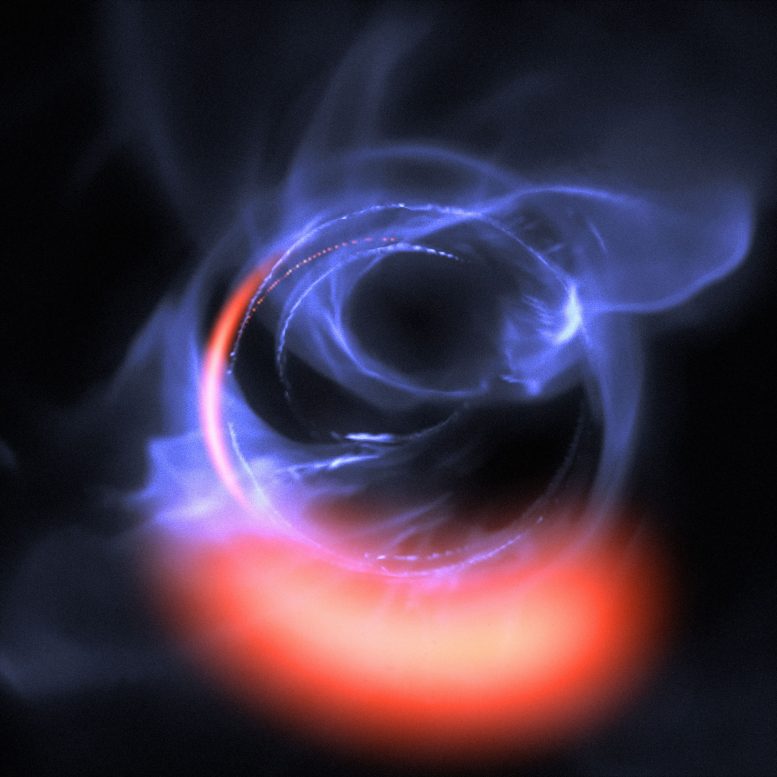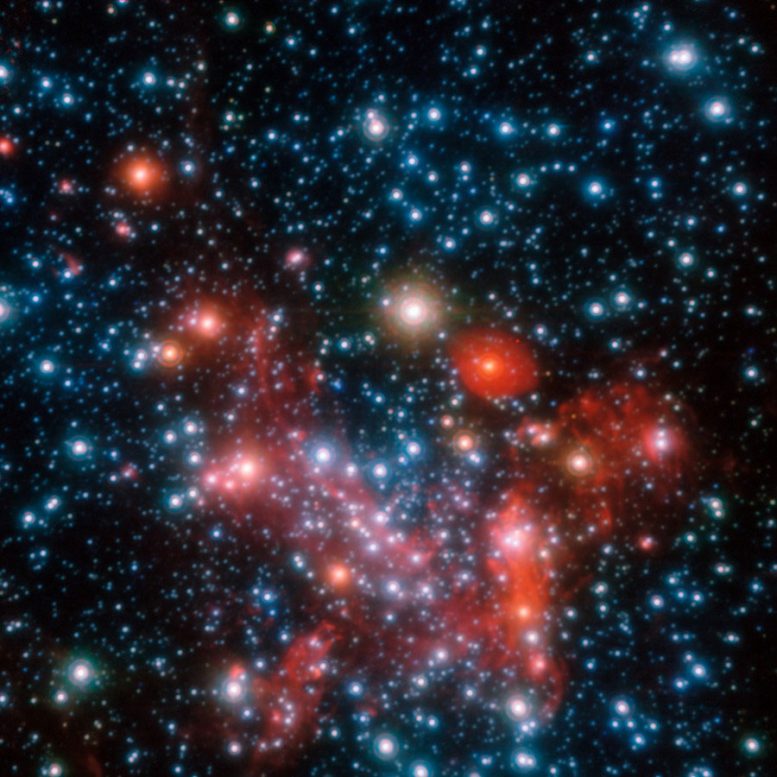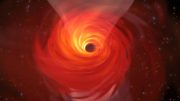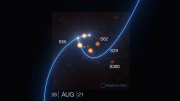
This visualization uses data from simulations of orbital motions of gas swirling around at about 30% of the speed of light on a circular orbit around the black hole. Credit: ESO/Gravity Consortium/L. Calçada
ESO’s exquisitely sensitive GRAVITY instrument has added further evidence to the long-standing assumption that a supermassive black hole lurks in the center of the Milky Way. New observations show clumps of gas swirling around at about 30% of the speed of light on a circular orbit just outside its event horizon — the first time material has been observed orbiting close to the point of no return, and the most detailed observations yet of material orbiting this close to a black hole.
ESO’s GRAVITY instrument on the Very Large Telescope (VLT) Interferometer has been used by scientists from a consortium of European institutions, including ESO, to observe flares of infrared radiation coming from the accretion disc around Sagittarius A*, the massive object at the heart of the Milky Way. The observed flares provide long-awaited confirmation that the object in the center of our galaxy is, as has long been assumed, a supermassive black hole. The flares originate from material orbiting very close to the black hole’s event horizon — making these the most detailed observations yet of material orbiting this close to a black hole.
While some matter in the accretion disc — the belt of gas orbiting Sagittarius A* at relativistic speeds — can orbit the black hole safely, anything that gets too close is doomed to be pulled beyond the event horizon. The closest point to a black hole that material can orbit without being irresistibly drawn inwards by the immense mass is known as the innermost stable orbit, and it is from here that the observed flares originate.
“It’s mind-boggling to actually witness material orbiting a massive black hole at 30% of the speed of light,” marveled Oliver Pfuhl, a scientist at the MPE. “GRAVITY’s tremendous sensitivity has allowed us to observe the accretion processes in real time in unprecedented detail.“
These measurements were only possible thanks to international collaboration and state-of-the-art instrumentation. The GRAVITY instrument which made this work possible combines the light from four telescopes of ESO’s VLT to create a virtual super-telescope 130 meters in diameter, and has already been used to probe the nature of Sagittarius A*.
This visualization uses data from simulations of orbital motions of gas swirling around at about 30% of the speed of light on a circular orbit around the supermassive black hole Sagittarius A*. Credit: ESO/Gravity Consortium/L. Calçada
Earlier this year, GRAVITY and SINFONI, another instrument on the VLT, allowed the same team to accurately measure the close fly-by of the star S2 as it passed through the extreme gravitational field near Sagittarius A*, and for the first time revealed the effects predicted by Einstein’s general relativity in such an extreme environment. During S2’s close fly-by, strong infrared emission was also observed.
“We were closely monitoring S2, and of course we always keep an eye on Sagittarius A*,” explained Pfuhl. “During our observations, we were lucky enough to notice three bright flares from around the black hole — it was a lucky coincidence!“
This emission, from highly energetic electrons very close to the black hole, was visible as three prominent bright flares, and exactly matches theoretical predictions for hot spots orbiting close to a black hole of four million solar masses. The flares are thought to originate from magnetic interactions in the very hot gas orbiting very close to Sagittarius A*.

The central parts of our Galaxy, the Milky Way, as observed in the near-infrared with the NACO instrument on ESO’s Very Large Telescope. By following the motions of the most central stars over more than 16 years, astronomers were able to determine the mass of the supermassive black hole that lurks there. Credit: ESO/S. Gillessen et al.
Reinhard Genzel, of the Max Planck Institute for Extraterrestrial Physics (MPE) in Garching, Germany, who led the study, explained: “This always was one of our dream projects but we did not dare to hope that it would become possible so soon.” Referring to the long-standing assumption that Sagittarius A* is a supermassive black hole, Genzel concluded that “the result is a resounding confirmation of the massive black hole paradigm.“
Reference: “Detection of orbital motions near the last stable circular orbit of the massive black hole SgrA*” by R. Abuter, A. Amorim, M. Bauböck, J. P. Berger, H. Bonnet, W. Brandner, Y. Clénet, V. Coudé du Foresto, P. T. de Zeeuw, C. Deen, J. Dexter, G. Duvert, A. Eckart, F. Eisenhauer, N. M. Förster Schreiber, P. Garcia, F. Gao1, E. Gendron, R. Genzel, S. Gillessen, P. Guajardo, M. Habibi, X. Haubois, Th. Henning, S. Hippler, M. Horrobin, A. Huber, A. Jiménez-Rosales, L. Jocou, P. Kervella, S. Lacour, V. Lapeyrère, B. Lazareff, J.-B. Le Bouquin, P. Léna, M. Lippa, T. Ott1, J. Panduro, T. Paumard, K. Perraut, G. Perrin, O. Pfuhl, P. M. Plewa, S. Rabien, G. Rodríguez-Coira, G. Rousset, A. Sternberg, O. Straub, C. Straubmeier, E. Sturm, L. J. Tacconi, F. Vincent, S. von Fellenberg, I. Waisberg, F. Widmann, E. Wieprecht, E. Wiezorrek, J. Woillez and S. Yazici, 31 October 2018, Astronomy & Astrophysics.
DOI: 10.1051/0004-6361/201834294









Why don’t they send a Satellite with Camera into a Black Hole, or are they too far away ?
Distance to nearest star from Earth is over 4 light years which is impossible to reach with current technology in any meaningful time-frame. Distance to V616 Monocerotis the nearest Black hole is over 3,000 light years away!
The qestion is how close to event horizont surface ( in let say
km etc. If milions or thousends of km or mabe milions or bilions km or thousend of light years etc ..)to event horizont??? Such sentence that ” close” mean ….nothing to a reader. Really nothing!! The second question is about the main picture at the begening of the article. Is it ONly artist ( photoshop fake) idea or exect computer graphic representation of motion of gas created by computer program calculations and based DIRECTLY on this observation and real efects of measurements??? This is very important to understand what is only a artistic visualization ( what is usually stupid or very bad for young readres) and what is real optical or gamma or ifrared etc efect of made measurements. Many interesting astrophisic articles including this are very badly written because do NOT explain clearly which are real photos/pictures and which are “fake” artistic “bla bla bla” …made sometimes after good…. beer in mentioned Photoshop.This is more and more often NOT clear on scientific www sides what is real, or what is ONLY PHOTOSHOP. But shouLd be clearly stated under each picture to avoid missunderstanding and to avoid confusion.
I believe that to have life on another planet(like on Earth) there must be the same gravity that we have here on Earth. This gravity will hold and sink the water to the roots of any plant material and make it grow and produce oxygen. Look for gravity first.